

Oil & Gas Geology ›› 2024, Vol. 45 ›› Issue (1): 15-30.doi: 10.11743/ogg20240102
• Petroleum Geology • Previous Articles Next Articles
Naxin TIAN1( ), Chenglin GONG2, Gaokui WU1, Kun QI2, Yijie ZHU2, Jingjing LIU1
), Chenglin GONG2, Gaokui WU1, Kun QI2, Yijie ZHU2, Jingjing LIU1
Received:2023-10-05
Revised:2023-11-14
Online:2024-02-01
Published:2024-02-29
CLC Number:
Naxin TIAN, Chenglin GONG, Gaokui WU, Kun QI, Yijie ZHU, Jingjing LIU. Development of submarine depositional systems under dynamic interplays between sediment gravity flows and seafloor topography: A case study of the Potiguar Basin on the equatorial Atlantic Ocean[J]. Oil & Gas Geology, 2024, 45(1): 15-30.
Add to citation manager EndNote|Reference Manager|ProCite|BibTeX|RefWorks
Table 1
Four major seismic facies documented in the study interval of the study area"
| 地震相及对应沉积解释 | 特征描述 | 典型地震剖面 | 典型RGB三色融合图 |
|---|---|---|---|
| 地震相1:深水水道[ | 剖面:振幅变化不定、低频、连续性较差的反射,底部为U/V型侵蚀面; 平面:条带状 | 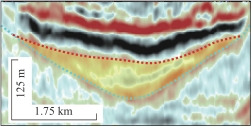 | 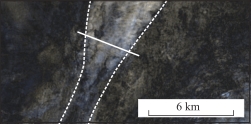 |
| 地震相2:朵叶体[ | 剖面:强振幅、中频、连续性较好的平行反射; 平面:在地震相1末端呈扇形或舌状堆积 | 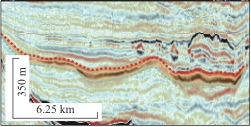 | 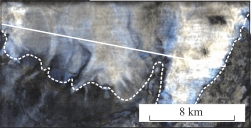 |
| 地震相3:块体搬运沉积复合体(MTCs)[ | 剖面:振幅变化不定的杂乱反射,具有侵蚀型底界面和不规则顶界面; 平面:拉长的不规则形态 |  | 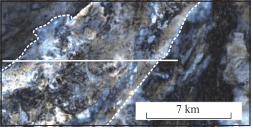 |
| 地震相4:深海披覆沉积[ | 剖面:低振幅、中高频、连续性较好的平行反射; 平面:席状 | 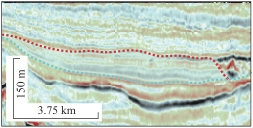 | 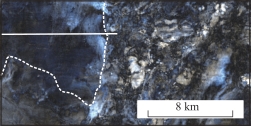 |
| 1 | POSAMENTIER H W, KOLLA V. Seismic geomorphology and stratigraphy of depositional elements in deep-water settings[J]. Journal of Sedimentary Research, 2003, 73(3): 367-388. |
| 2 | MAYALL M, JONES E, CASEY M. Turbidite channel reservoirs—Key elements in facies prediction and effective development[J]. Marine and Petroleum Geology, 2006, 23(8): 821-841. |
| 3 | 秦雁群, 万仑坤, 计智锋, 等. 深水块体搬运沉积体系研究进展[J]. 石油与天然气地质, 2018, 39(1): 140-152. |
| QIN Yanqun, WAN Lunkun, JI Zhifeng, et al. Progress of research on deep-water mass-transport deposits[J]. Oil & Gas Geology, 2018, 39(1): 140-152. | |
| 4 | 林畅松. 盆地沉积动力学: 研究现状与未来发展趋势[J]. 石油与天然气地质, 2019, 40(4): 685-700. |
| LIN Changsong. Sedimentary dynamics of basin: Status and trend[J]. Oil & Gas Geology, 2019, 40(4): 685-700. | |
| 5 | WEIMER P, SLATT R M, BOUROULLEC R, et al. Introduction to the petroleum geology of deepwater setting[M]. Tulsa: American Association of Petroleum Geologists, 2006: 57-111. |
| 6 | MCHARGUE T, PYRCZ M J, SULLIVAN M D, et al. Architecture of turbidite channel systems on the continental slope: Patterns and predictions[J]. Marine and Petroleum Geology, 2011, 28(3): 728-743. |
| 7 | COVAULT J A, KOSTIC S, PAULL C K, et al. Cyclic steps and related supercritical bedforms: Building blocks of deep-water depositional systems, western North America[J]. Marine Geology, 2017, 393: 4-20. |
| 8 | STOW D A V, READING H G, COLLINSON J D. Deep seas[M]//READING H G. Sedimentary Environments: Processes, Facies, and Stratigraphy. 3rd ed. Cambridge: Blackwell Science, 1996: 395-453. |
| 9 | RICHARDS M, BOWMAN M, READING H. Submarine-fan systems i: Characterization and stratigraphic prediction[J]. Marine and Petroleum Geology, 1998, 15(7): 689-717. |
| 10 | KOLLA V. A review of sinuous channel avulsion patterns in some major deep-sea fans and factors controlling them[J]. Marine and Petroleum Geology, 2007, 24(6/9): 450-469. |
| 11 | PICOT M, DROZ L, MARSSET T, et al. Controls on turbidite sedimentation: Insights from a quantitative approach of submarine channel and lobe architecture (Late Quaternary Congo Fan)[J]. Marine and Petroleum Geology, 2016, 72: 423-446. |
| 12 | ZHAO Xiaoming, QI Kun, LIU Li, et al. Development of a partially-avulsed submarine channel on the Niger Delta continental slope: Architecture and controlling factors[J]. Marine and Petroleum Geology, 2018, 95: 30-49. |
| 13 | HUYGHE P, FOATA M, DEVILLE E, et al. Channel profiles through the active thrust front of the southern Barbados prism[J]. Geology, 2004, 32(5): 429-432. |
| 14 | FERRY J N, MULDER T, PARIZE O, et al. Concept of equilibrium profile in deep-water turbidite system: effects of local physiographic changes on the nature of sedimentary process and the geometries of deposits[J]. Geological Society, London, Special Publications, 2005, 244(1): 181-193. |
| 15 | GEE M J R, GAWTHORPE R L. Submarine channels controlled by salt tectonics: Examples from 3D seismic data offshore Angola[J]. Marine and Petroleum Geology, 2006, 23(4): 443-458. |
| 16 | CLARK I R, CARTWRIGHT J A. Interactions between submarine channel systems and deformation in deepwater fold belts: Examples from the Levant Basin, Eastern Mediterranean sea[J]. Marine and Petroleum Geology, 2009, 26(8): 1465-1482. |
| 17 | JOLLY B A, LONERGAN L, WHITTAKER A C. Growth history of fault-related folds and interaction with seabed channels in the toe-thrust region of the deep-water Niger Delta[J]. Marine and Petroleum Geology, 2016, 70: 58-76. |
| 18 | ZUCKER E, GVIRTZMAN Z, STEINBERG J, et al. Diversion and morphology of submarine channels in response to regional slopes and localized salt tectonics, Levant Basin[J]. Marine and Petroleum Geology, 2017, 81: 98-111. |
| 19 | SMITH R. Silled sub-basins to connected tortuous corridors: sediment distribution systems on topographically complex sub-aqueous slopes[J]. Geological Society, London, Special Publications, 2004, 222(1): 23-43. |
| 20 | BEAUBOUEF R T, ABREU V. Basin 4 of the Brazos-Trinity slope system: Anatomy of the terminal portion of an intra-slope lowstand systems tract[J]. Gulf Coast Association of Geological Societies Transactions, 2006, 56: 39-49. |
| 21 | ZHAO Xiaoming, LI Minghua, QI Kun, et al. Development of a distinct submarine depositional system on a topographically complex Niger Delta slope[J]. Geological Journal, 2020, 55(5): 3732-3747. |
| 22 | MOSCARDELLI L, WOOD L, MANN P. Mass-transport complexes and associated processes in the offshore area of Trinidad and Venezuela[J]. AAPG Bulletin, 2006, 90(7): 1059-1088. |
| 23 | BULL S, CARTWRIGHT J, HUUSE M. A review of kinematic indicators from mass-transport complexes using 3D seismic data[J]. Marine and Petroleum Geology, 2009, 26(7): 1132-1151. |
| 24 | ALVES T M. Submarine slide blocks and associated soft-sediment deformation in deep-water basins: A review[J]. Marine and Petroleum Geology, 2015, 67: 262-285. |
| 25 | KNELLER B. The influence of flow parameters on turbidite slope channel architecture[J]. Marine and Petroleum Geology, 2003, 20(6/8): 901-910. |
| 26 | FRANCE-LANORD C, SPIESS V, KLAUS A, et al. Neogene and Late Paleogene record of Himalayan orogeny and climate: A transect across the Middle Bengal Fan: International Ocean Discovery Program expedition 354 preliminary report[R]. College Station: IODP, 2015. |
| 27 | GONG Chenglin, WANG Haiqiang, SHAO Dali, et al. How did the world’s largest submarine fan in the Bay of Bengal grow and evolve at the subfan scale?[J]. AAPG Bulletin, 2022, 106(7): 1431-1451. |
| 28 | DARROS DE MATOS R M. Tectonic evolution of the equatorial South Atlantic[M]//MOHRIAK W, TAIWANI M. Atlantic Rifts and Continental Margins. Washington, D.C.: American Geophysical Union, 2000: 331-354. |
| 29 | BROWNFIELD M E, CHARPENTIER R R. Geology and total petroleum systems of the Gulf of Guinea province of West Africa: b2207C[R]. Reston: U.S. Geological Survey, 2006: 32. |
| 30 | STOLTE J T, DARDEN M P. Testing the Atlantic Mirror theory[J]. Oil & Gas Financial Journal, 2013, 10(4): 18-20, 22-23. |
| 31 | MAIA DE ALMEIDA N, ALVES T M, NEPOMUCENO FILHO F, et al. Tectono-sedimentary evolution and petroleum systems of the Mundaú subbasin: A new deep-water exploration frontier in equatorial Brazil[J]. AAPG Bulletin, 2020, 104(4): 795-824. |
| 32 | CRUZ PESSOA NETO O DA, SOARES U M, SILVA J G F DA, et al. Bacia Potiguar[J]. Boletim de Geociencias-Petrobras, Rio de Janeiro, 2007, 15(2): 357-369. |
| 33 | MELO A H, ANDRADE P R O, MAGALHÃES A J C, et al. Stratigraphic evolution from the early Albian to late Campanian of the Potiguar Basin, Northeast Brazil: An approach in seismic scale[J]. Basin Research, 2020, 32(5): 1054-1080. |
| 34 | SILVA E B DA, SEVERIANO RIBEIRO H J P, SOARES DE SOUZA E. Exploration plays of the Potiguar Basin in deep and ultra-deep water, Brazilian Equatorial Margin[J]. Journal of South American Earth Sciences, 2021, 111: 103454. |
| 35 | DE OLIVEIRA CUNHA J A, CÓRDOBA V C, SOARES U M, et al. Evolution of shallow and deep-water deposits included in the regressive drift succession of the Potiguar Basin (Brazilian Equatorial Margin) during the Late Cretaceous to Holocene[J]. Journal of South American Earth Sciences, 2021, 110: 103420. |
| 36 | FONSECA J C L G, VITAL H, PEREZ Y A R, et al. Seismic stratigraphy of a deep water basin in the Brazilian equatorial margin: The eastern portion of Potiguar Basin and Touros High[J]. Geo-Marine Letters, 2020, 40(6): 977-988. |
| 37 | DEPTUCK M E, SYLVESTER Z, PIRMEZ C, et al. Migration-aggradation history and 3-D seismic geomorphology of submarine channels in the Pleistocene Benin-major Canyon, western Niger Delta slope[J]. Marine and Petroleum Geology, 2007, 24(6/9): 406-433. |
| 38 | HANSEN L, L’HEUREUX J S, SAUVIN G, et al. Effects of mass-wasting on the stratigraphic architecture of a fjord-valley fill: Correlation of onshore, shear-wave seismic and marine seismic data at Trondheim, Norway[J]. Sedimentary Geology, 2013, 289: 1-18. |
| 39 | SALLER A, WERNER K, SUGIAMAN F, et al. Characteristics of Pleistocene deep-water fan lobes and their application to an upper Miocene reservoir model, offshore East Kalimantan, Indonesia[J]. AAPG Bulletin, 2008, 92(7): 919-949. |
| 40 | CROSS N E, CUNNINGHAM A, COOK R J, et al. Three-dimensional seismic geomorphology of a deep-water slope-channel system: The Sequoia field, offshore west Nile Delta, Egypt[J]. AAPG Bulletin, 2009, 93(8): 1063-1086. |
| 41 | FILDANI A, HUBBARD S M, COVAULT J A, et al. Erosion at inception of deep-sea channels[J]. Marine and Petroleum Geology, 2013, 41: 48-61. |
| 42 | MAIER K L, FILDANI A, PAULL C K, et al. Deep-sea channel evolution and stratigraphic architecture from inception to abandonment from high-resolution Autonomous Underwater Vehicle surveys offshore central California[J]. Sedimentology, 2013, 60(4): 935-960. |
| 43 | KOSTIC S. Modeling of submarine cyclic steps: Controls on their formation, migration, and architecture[J]. Geosphere, 2011, 7(2): 294-304. |
| 44 | SPINEWINE B, SEQUEIROS O E, GARCIA M H, et al. Experiments on wedge-shaped deep sea sedimentary deposits in minibasins and/or on channel levees emplaced by turbidity currents. Part II. Morphodynamic evolution of the wedge and of the associated bedforms[J]. Journal of Sedimentary Research, 2009, 79(8): 608-628. |
| 45 | GAY A. Reply to comment on: Seafloor facies related to upward methane flux within a Giant Pockmark of the Lower Congo Basin[J]. Marine Geology, 2006, 232(1/2): 103-104. |
| 46 | POSAMENTIER H W, KOLLA V, 刘化清. 深水浊流沉积综述[J]. 沉积学报, 2019, 37(5): 879-903. |
| POSAMENTIER H W, KOLLA V, LIU Huaqing. An overview of deep-water turbidite deposition[J]. Acta Sedimentologica Sinica, 2019, 37(5): 879-903. | |
| 47 | SHANMUGAM G. Submarine fans: A critical retrospective (1950-2015)[J]. Journal of Palaeogeography, 2016, 5(2): 110-184. |
| 48 | ORTIZ-KARPF A, HODGSON D M, JACKSON C A L, et al. Influence of seabed morphology and substrate composition on mass-transport flow processes and pathways: Insights from the Magdalena Fan, offshore Colombia[J]. Journal of Sedimentary Research, 2017, 87(3): 189-209. |
| 49 | QIN Yongpeng, ALVES T M, CONSTANTINE J, et al. The role of mass wasting in the progressive development of submarine channels (Espírito Santo Basin, SE Brazil)[J]. Journal of Sedimentary Research, 2017, 87(5): 500-516. |
| 50 | GAMBOA D, ALVES T M. Bi-modal deformation styles in confined mass-transport deposits: Examples from a salt minibasin in SE Brazil[J]. Marine Geology, 2016, 379: 176-193. |
| 51 | WU Gaokui, KONG Fanjun, TIAN Naxin, et al. Structural characteristics and deep-water hydrocarbon accumulation model of the Scotian Basin, Eastern Canada[J]. Energy Geoscience, 2023, 4(3): 100152. |
| 52 | 田纳新, 龚承林, 吴高奎, 等. 转换陆缘海底扇的沉积特征与沉积模式——以赤道大西洋漂移晚期陆缘为例[J]. 沉积学报, 2023, 41(6): 1798-1809. |
| TIAN Naxin, GONG Chenglin, WU Gaokui, et al. Depositional characteristics and models of submarine fans on transform margins: A case study from the late drift stage of the equatorial Atlantic margin[J]. Acta Sedimentologica Sinica, 2023, 41(6): 1798-1809. | |
| 53 | 吴高奎, 张忠民, 陈华, 等. 下刚果盆地中新统重力流沉积演化及控制因素[J]. 沉积学报, 2023, 41(1): 73-84. |
| WU Gaokui, ZHANG Zhongmin, CHEN Hua, et al. Sedimentary evolution and controlling factors of Miocene gravity flow deposits in the Lower Congo Basin[J]. Acta Sedimentologica Sinica, 2023, 41(1): 73-84. | |
| 54 | WU Wei, LI Quan, YU Jing, et al. The central canyon depositional patterns and filling process in east of Lingshui Depression, Qiongdongnan Basin, northern South China Sea[J]. Geological Journal, 2018, 53(6): 3064-3081. |
| Viewed | ||||||
|
Full text |
|
|||||
|
Abstract |
|
|||||